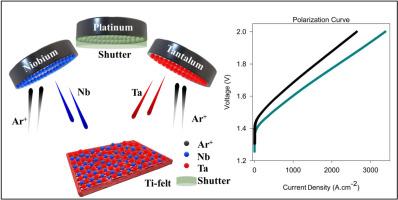Porous transport layers with low Pt loading having Nb–Ta alloy as interlayer for proton exchange membrane water electrolyzers
IF 8.1
2区 工程技术
Q1 CHEMISTRY, PHYSICAL
引用次数: 0
Abstract
Titanium (Ti), commercially used as substrate for porous transport layers (PTLs) in proton exchange membrane water electrolyzers (PEMWEs), tends to form passivating oxide layer, increasing interfacial contact resistance (ICR) and reducing performance and durability; practice of using precious metal coatings for mitigation significantly increases costs. This study investigates niobium-tantalum (Nb–Ta) alloys as cost-effective interlayer coatings on Ti-felt to reduce precious metal loading. Nb–Ta coated samples significantly increase corrosion potential, lower current densities by 3–4 orders of magnitude, reduce ICR by 3.5 times, and improve durability. The best performance sample with an ultra-low amount of platinum, shows 8 times greater durability, 12.5% reduction in ohmic resistance and 28% increase in current density at +2.0 V than the commercial PTL in a single cell stack. Improved contact angle, electrical, and thermal conductivity highlight Nb–Ta interlayer coatings for PTLs, offering a cost-effective strategy to enhance PEMWE performance and durability for green hydrogen production.

用于质子交换膜水电解槽的以 Nb-Ta 合金为中间层的低铂载量多孔传输层
钛(Ti)是质子交换膜水电解槽(PEMWE)中多孔传输层(PTL)的商用基材,容易形成钝化氧化层,增加界面接触电阻(ICR),降低性能和耐用性;使用贵金属涂层进行缓解的做法大大增加了成本。本研究将铌钽(Nb-Ta)合金作为钛毡上具有成本效益的层间涂层,以减少贵金属负载。Nb-Ta 涂层样品可显著提高腐蚀电位,将电流密度降低 3-4 个数量级,将 ICR 降低 3.5 倍,并提高耐久性。与单电池堆中的商用 PTL 相比,超低铂含量的最佳性能样品的耐用性提高了 8 倍,欧姆电阻降低了 12.5%,+2.0 V 时的电流密度提高了 28%。PTL 的接触角、电导率和热导率的改善凸显了 Nb-Ta 层间涂层的优势,为提高 PEMWE 性能和耐用性以实现绿色制氢提供了一种具有成本效益的策略。
本文章由计算机程序翻译,如有差异,请以英文原文为准。
求助全文
约1分钟内获得全文
求助全文
来源期刊

International Journal of Hydrogen Energy
工程技术-环境科学
CiteScore
13.50
自引率
25.00%
发文量
3502
审稿时长
60 days
期刊介绍:
The objective of the International Journal of Hydrogen Energy is to facilitate the exchange of new ideas, technological advancements, and research findings in the field of Hydrogen Energy among scientists and engineers worldwide. This journal showcases original research, both analytical and experimental, covering various aspects of Hydrogen Energy. These include production, storage, transmission, utilization, enabling technologies, environmental impact, economic considerations, and global perspectives on hydrogen and its carriers such as NH3, CH4, alcohols, etc.
The utilization aspect encompasses various methods such as thermochemical (combustion), photochemical, electrochemical (fuel cells), and nuclear conversion of hydrogen, hydrogen isotopes, and hydrogen carriers into thermal, mechanical, and electrical energies. The applications of these energies can be found in transportation (including aerospace), industrial, commercial, and residential sectors.
 求助内容:
求助内容: 应助结果提醒方式:
应助结果提醒方式:


